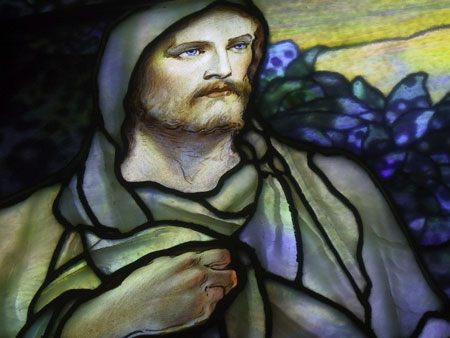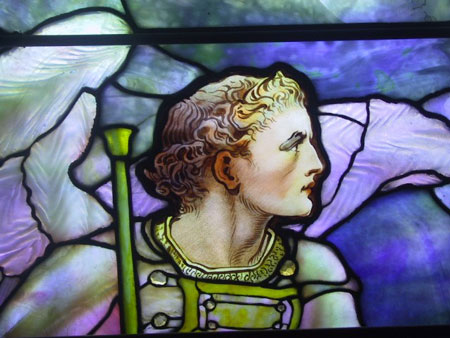
This is a double window, both images done by Tiffany.
Lower Subject:The Road to Emmaus
Inscription:
Dedication: In memory of Rawleigh W. Downman, 1860-1881 and James H. Downman, 1862-1911, sons of William Yates and Mary Ann Downman. This was the first Tiffany installed at St. George’s in 1912.
Tiffany Studios produced three windows for Saint George’s Episcopal Church between 1912 and 1917. Each was intended as a memorial to specific members of the congregation, the earliest being the double window installed in 1912 on the left side of the nave.
Mary Ann Downman was 90 years old in 1923, living in the same home that she was married and was the oldest person in Fredericksburg at the time.
She had six children, three that predeceased her. One child Rev John Yates Downman (1858-1949) became rector at St. Paul’s Episcopal in Richmond. The window was dedicated to two of her sons who had predeceased her. Rawleigh Downman died at age 21 visiting an uncle at Baltimore when he died. James Downman was a successful New York businessman who had suffered a stroke and returned to his sister Nannie’s home. There he was the victim of a hunting accident.
Maker/Date: Tiffany Studios, New York, 1912
Description –
This window is located over the north side of the Church and receives the afternoon sun.
The story of this window is from Luke, chapter 24, verses 13 to 35. Two disciples encounter Jesus shortly after his resurrection. The look of incredulity and awe on the faces of the men stands in contrast to the dignity and still expression of Christ.
In the image, Cleopas and an unnamed companion encounter the risen Christ on the road to Emmaus about seven miles from Jerusalem. The men are shocked that anyone could have been in Jerusalem and not known of the events that have happened there. “Abide with us,” they ask the unrecognized stranger, “for it is toward evening, and the day is far spent.” It was not until they offered Him hospitality and He blessed and broke the bread that they recognized Him. He soon disappeared. They got up and returned at once to Jerusalem. There they found the Eleven and those with them, assembled together and saying, “It is true! The Lord has risen and has appeared to Simon.”
Techniques –
Christ faces toward us, but the men are turned inward, a compositional device that gives the illusion of depth. As in most figural windows by Tiffany Studios, the faces and arms are painted with enamel. Drapery glass creates ripples of undulating fabric, as well as areas of shading, realistically depicting the figures’ forms. Plated spotted and confetti glass are used to portray the dappled leaves on the trees in the background. To make confetti glass, small, irregularly shaped pieces of glass are embedded to the reverse of a sheet of glass.
In the Biblical passage, the two disciples do not recognize Christ when they meet him. To convey this mystical aspect of Christ, the artist took into account the window’s placement in the church in relation to the composition of the window. Without illumination from the sun, the features of Christ’s face are unrecognizable. But in daylight, Christ’s identity is apparent to the men and the viewer alike.
The faces of the two companions show apprehension as they study the unknown man. The dark brown and green clothing contrasts with the lighter shades used in Christ’s robe.

Upper Subject: Angels with Trumpet and Incense
Inscription: none
Dedication: In memory of Rawleigh W. Downman, 1860-1881 and James H. Downman, 1862-1911, sons of William Yates and Mary Ann Downman. This was the first Tiffany installed at St. George’s in 1912.
Unlike the other Tiffany windows at St. George’s where only the lower portion of the window was created by Tiffany, this window has two separate Tiffany windows.
Maker/Date: Tiffany Studios, New York, 1912
Description – The subject of this window is from the Book of Revelation 9:13 – “The sixth angel blew his trumpet; and I heard a single voice speaking from among the horns of the golden incense altar which is in the presence of God.”
There are seven trumpets in Revelation, each signaling the issuing of God’s judgment on earth Angels bring God’s judgment on earth in Revelation. The blowing of these trumpets may correspond to the New Moon (or New Month) festivals in the Old Testament. Each new moon trumpet blowing was understood as a day of judgment in miniature, which warned people to prepare for the final judgment ushered in by the Feast of Trumpets and to call people back to a covenant relationship with God. When the seventh trumpet blew, it was to announce the Day of Atonement was at hand
Before the seventh angel blew his trumpet in Revelation 11, John was asked by a mighty angel (with right foot on the sea and left foot on the land) to eat the scroll telling of the things to happen (first tasting like honey, then souring his stomach) and yet to continue to prophesy further. John was told that the “holy city” (Jerusalem) would be trampled for “42 months,” during which two prophets/witnesses would tell about God, then would be killed, and would rise to heaven after 3 1/2 days — with an earthquake collapsing a tenth of the city.
This image captures the calm before the storm— the angel on the left is the seventh trumpeter, and the angel on the right bears incense. Behind the kneeling angels, billowing cloud rise up, parting at the top to reveal a glistening vision of Jerusalem. The hair and faces are painted with the reddish hair that is particularly noticeable.
Techniques –
The upper window shows the city of Jerusalem, coming down from heaven, emerging from a backdrop of opalescent glass of blues, browns, and greens. The Jerusalem image fades into the background. The city shows buildings with columns and onion skin domes.
The city was painted onto a sheet of colored glass with enamel. A sheet of spotted glass was then laid or plated on top, creating a sense of sunlit distance. Spotted glass was made by adding fluorine during the firing process— the fluorine crystallized and caused the spots. Drapery glass is used to produce ripples of varying hues and tints in the angels’ gowns. This type of glass has been bent and folded to produce ripples that create an illusion of depth. The solemn pose of the angels contrasts with the iridescent glimmer of the city that hovers above, instilling the design with surreal grandeur and a sense of what is to come.
